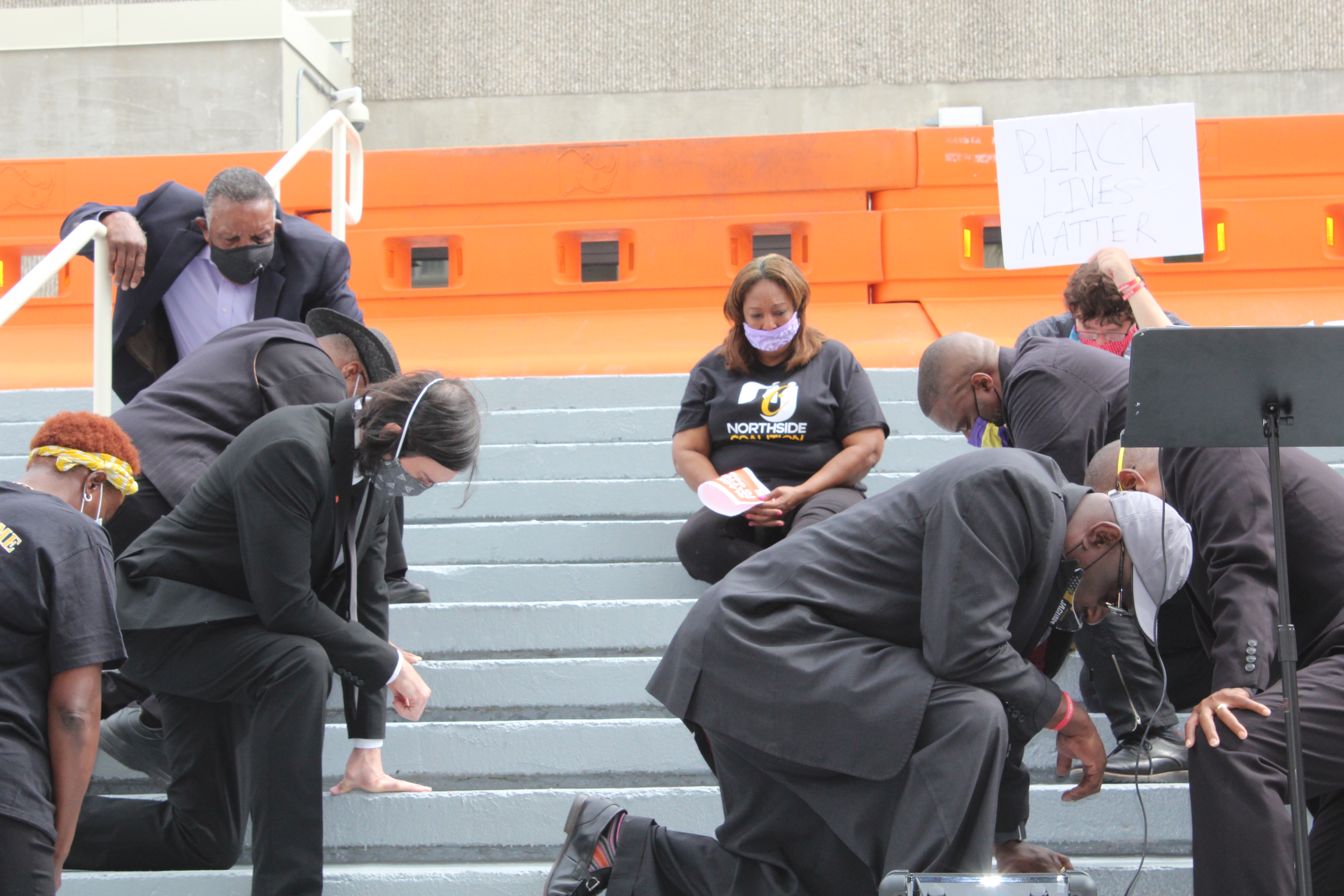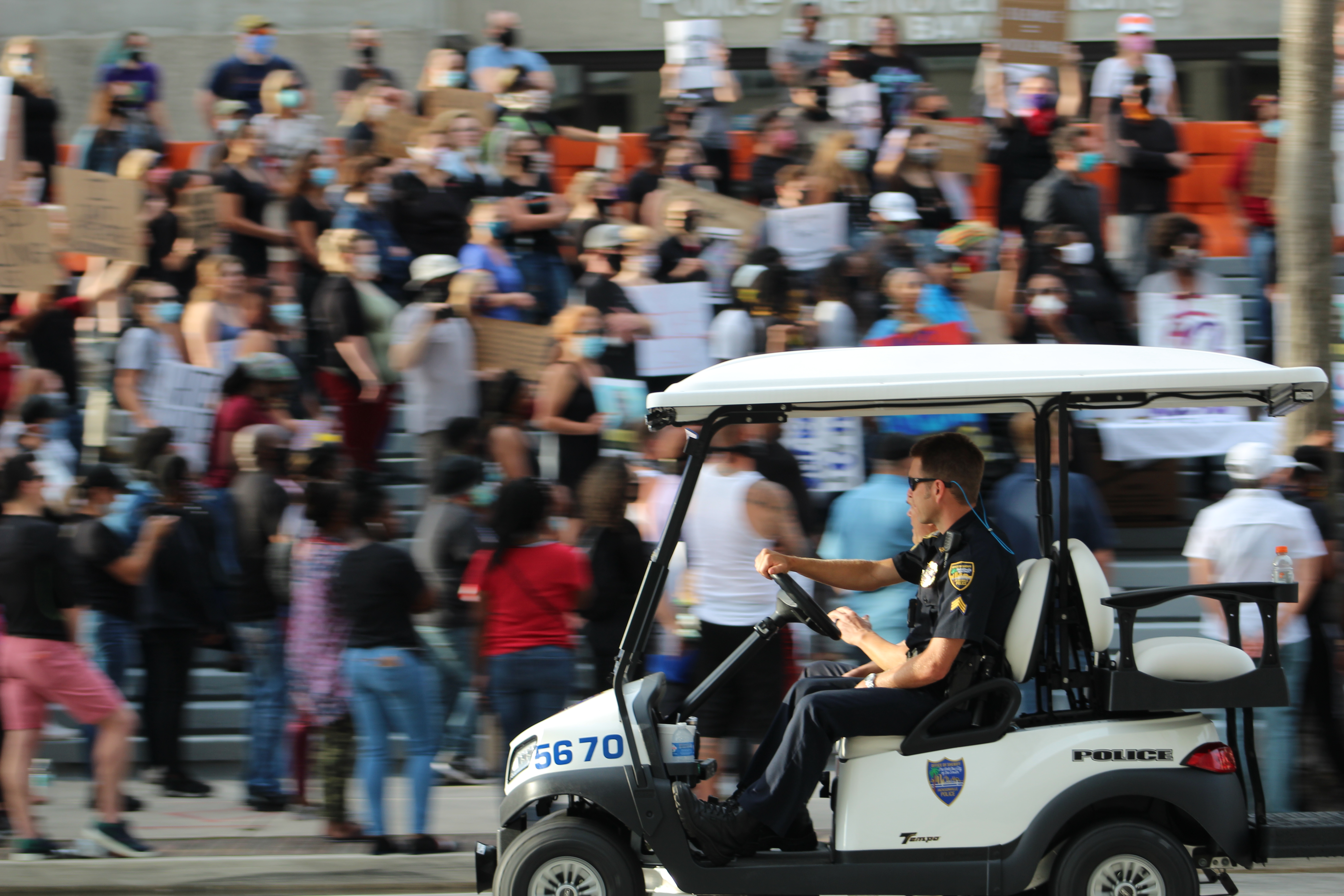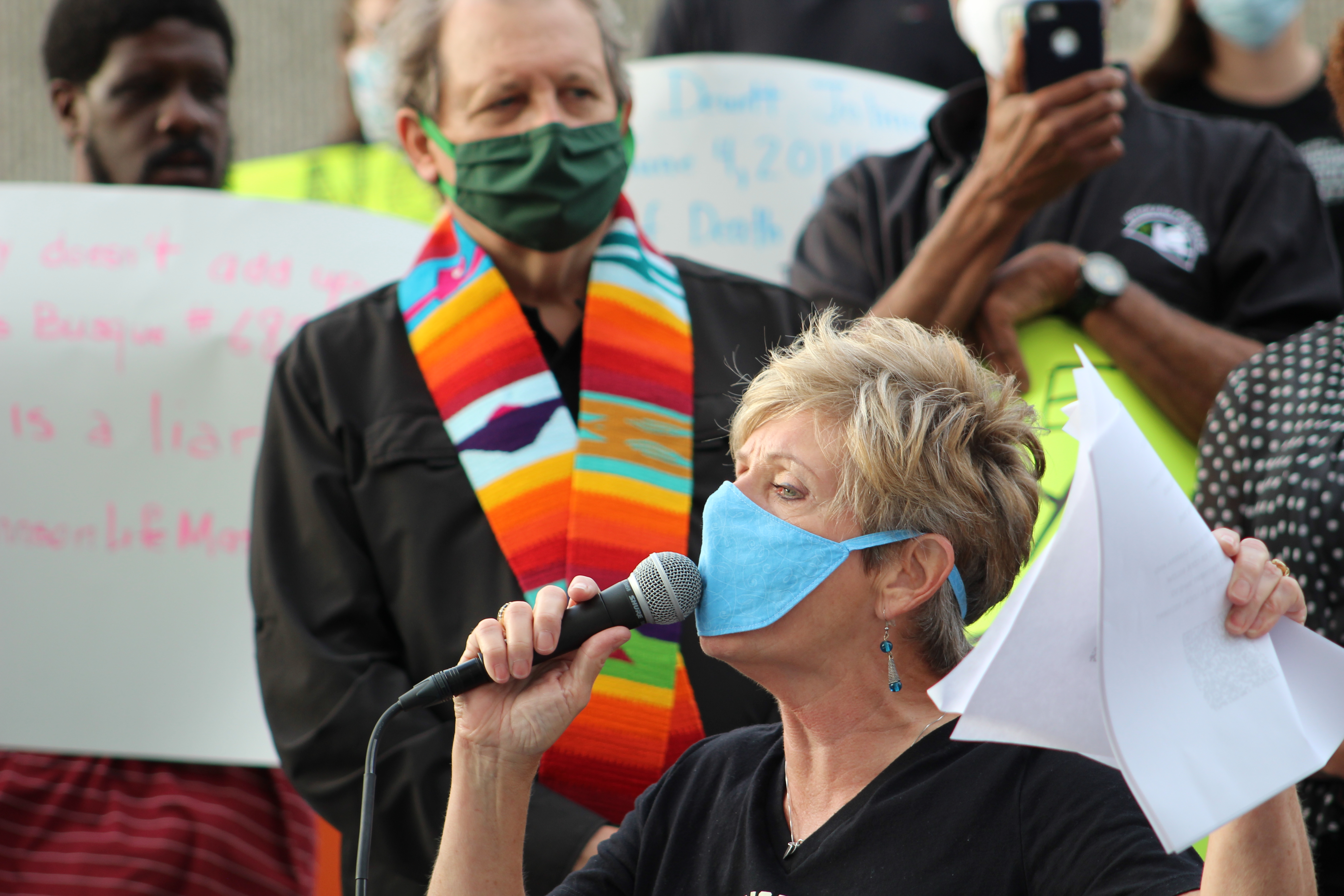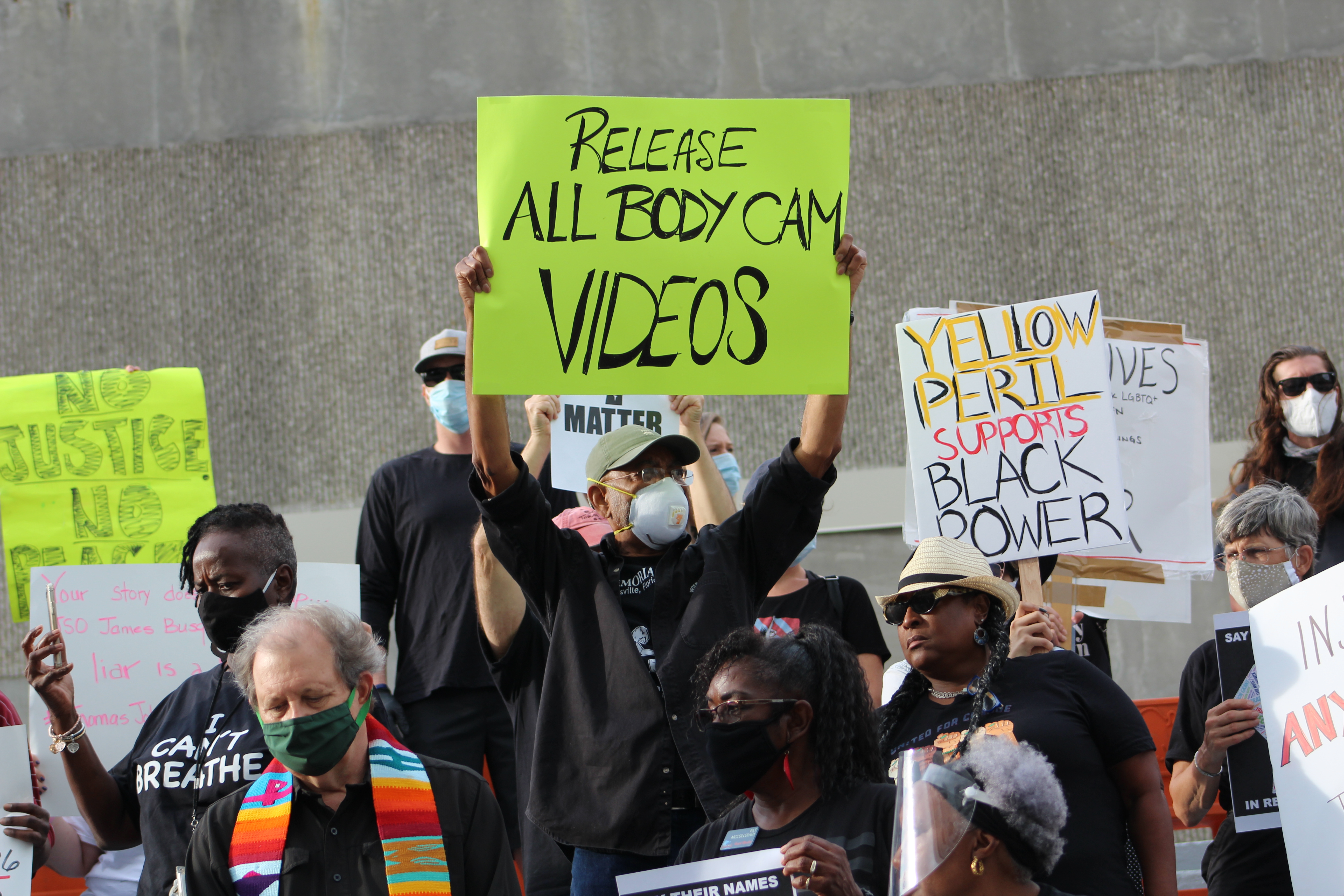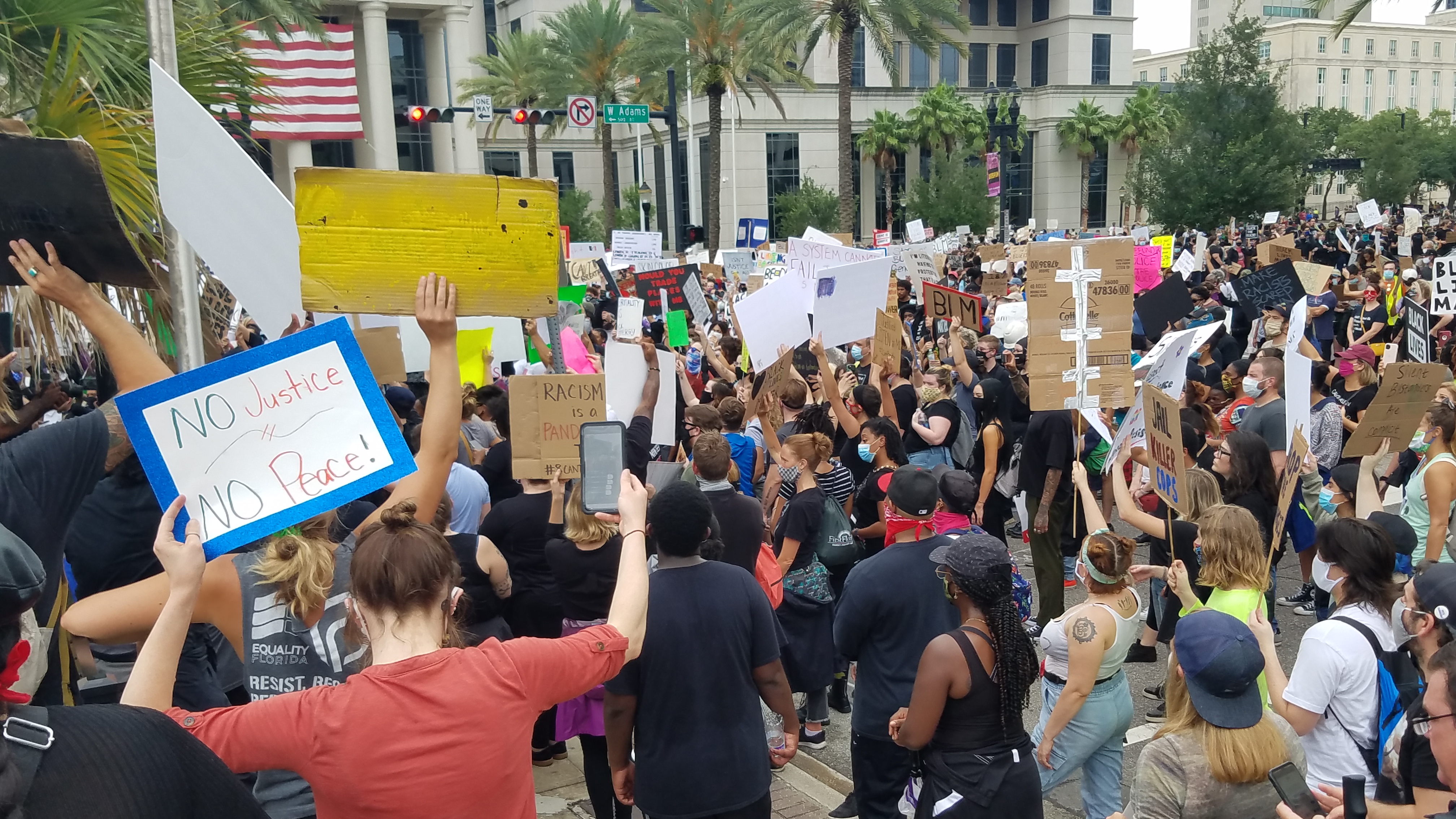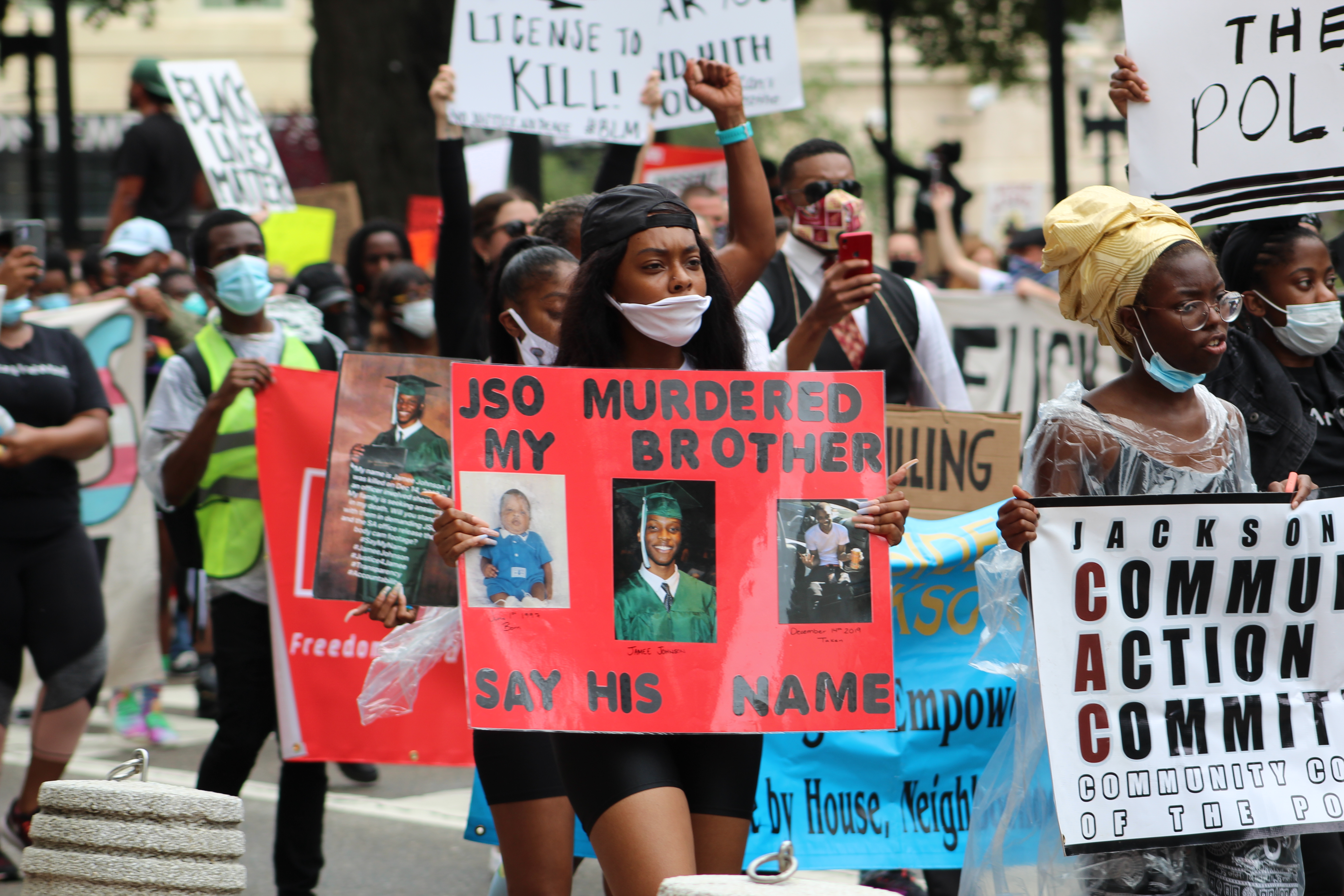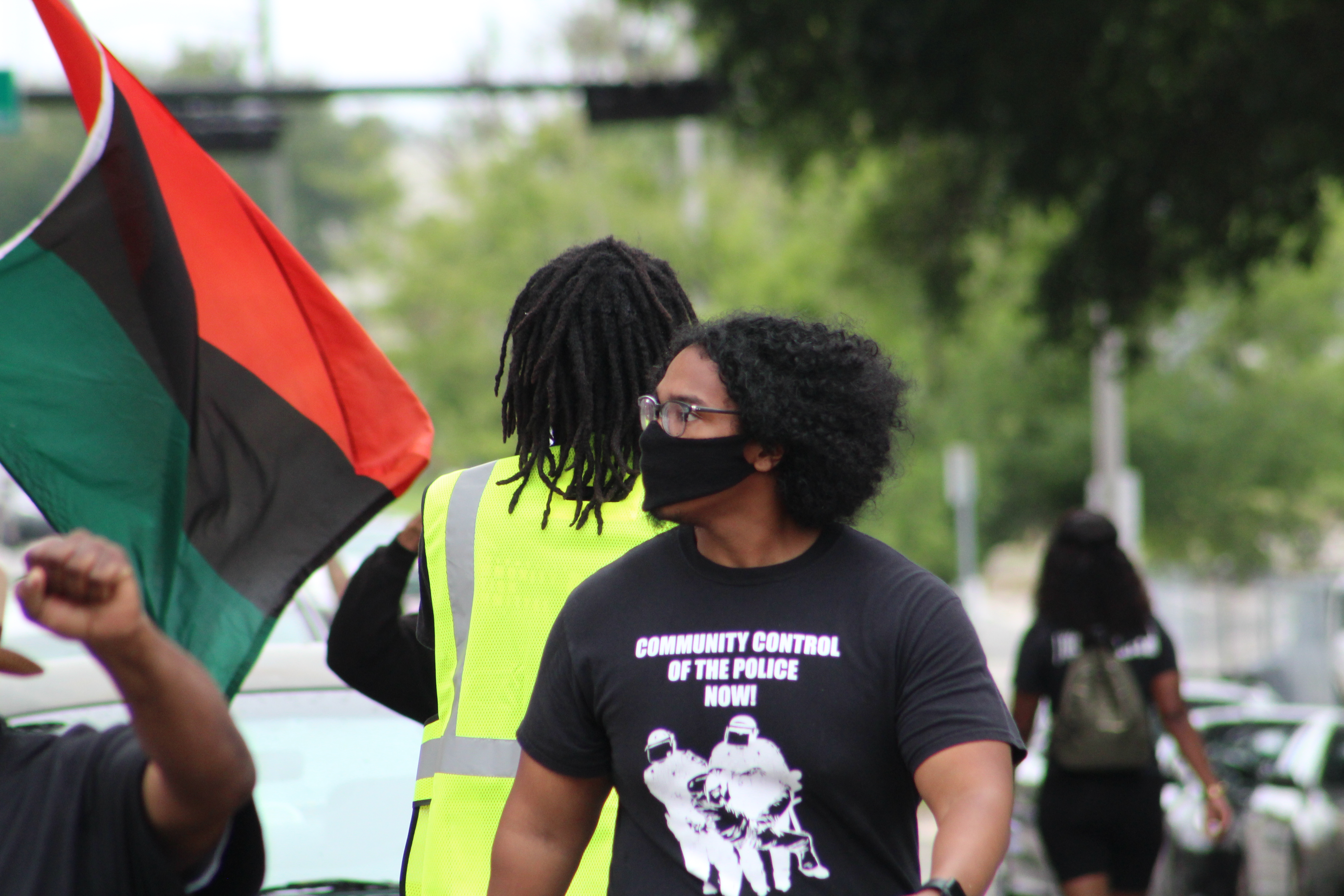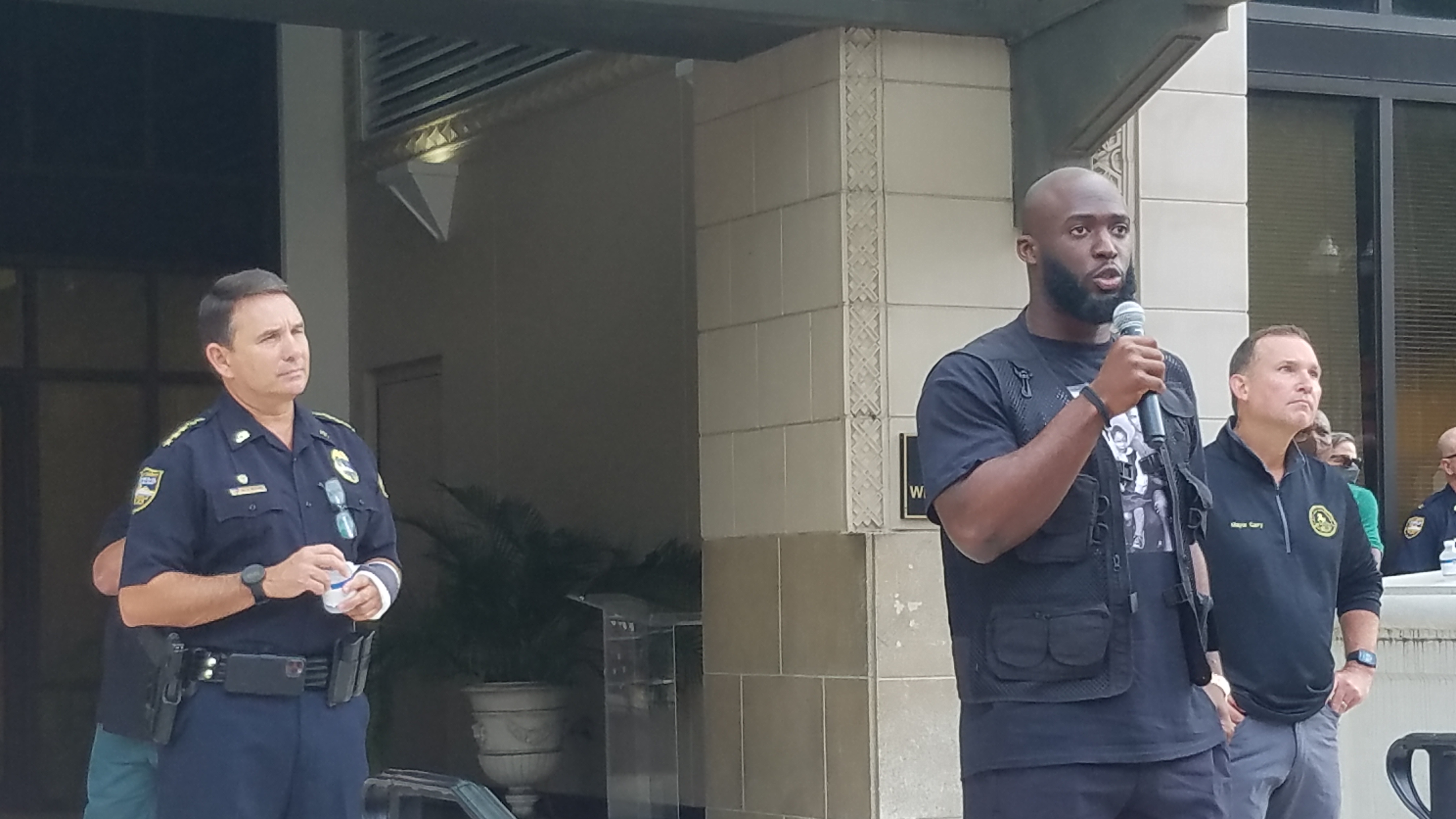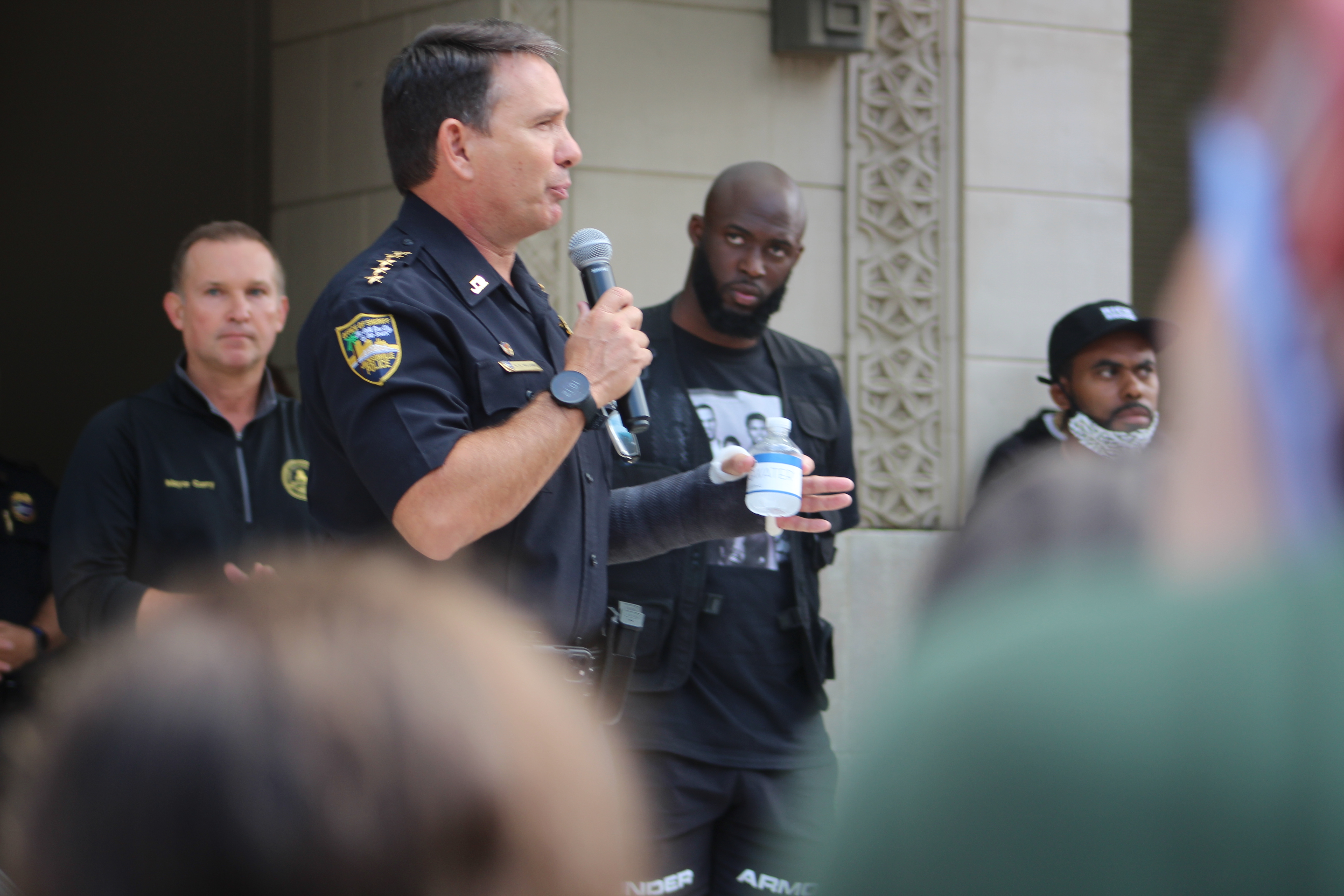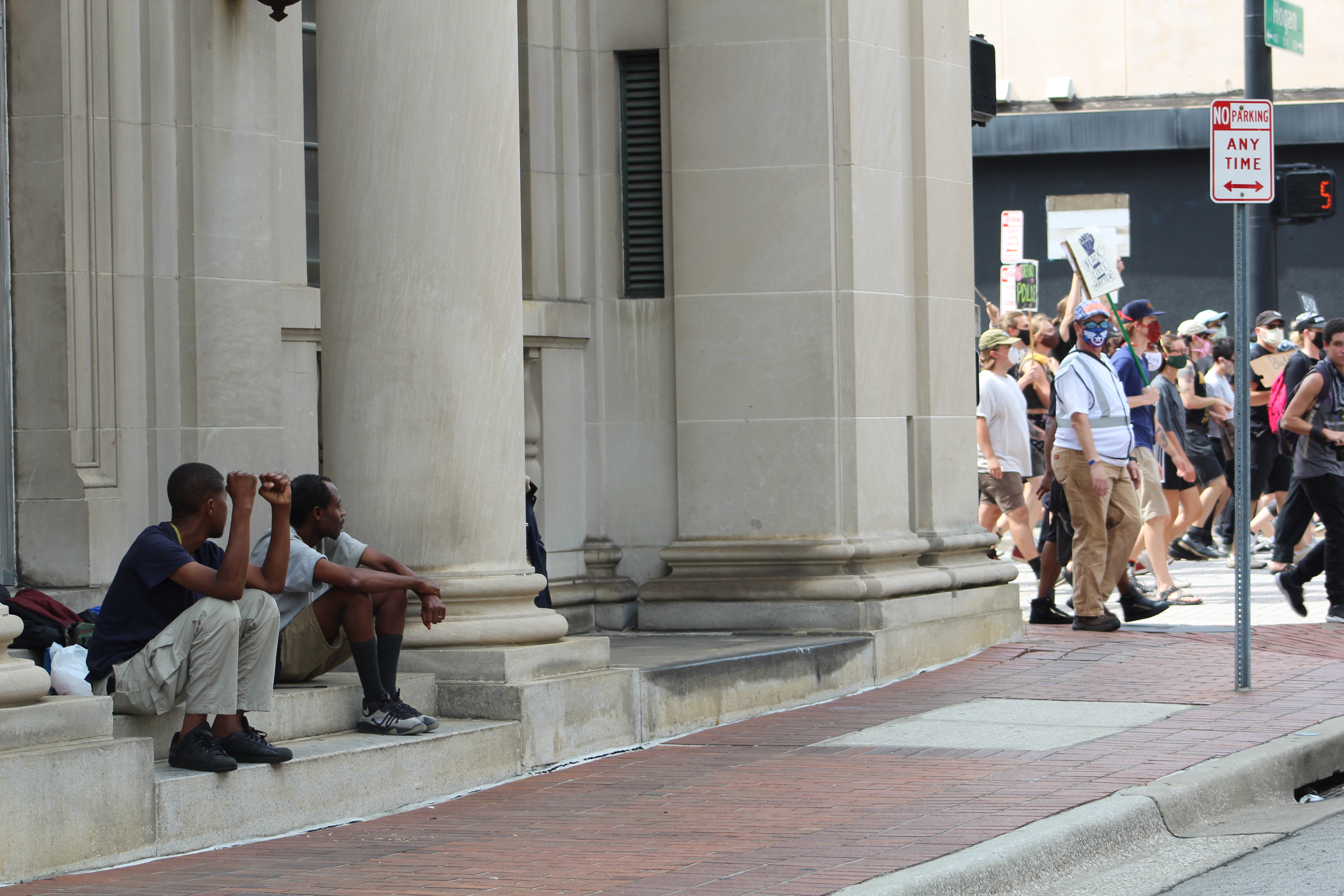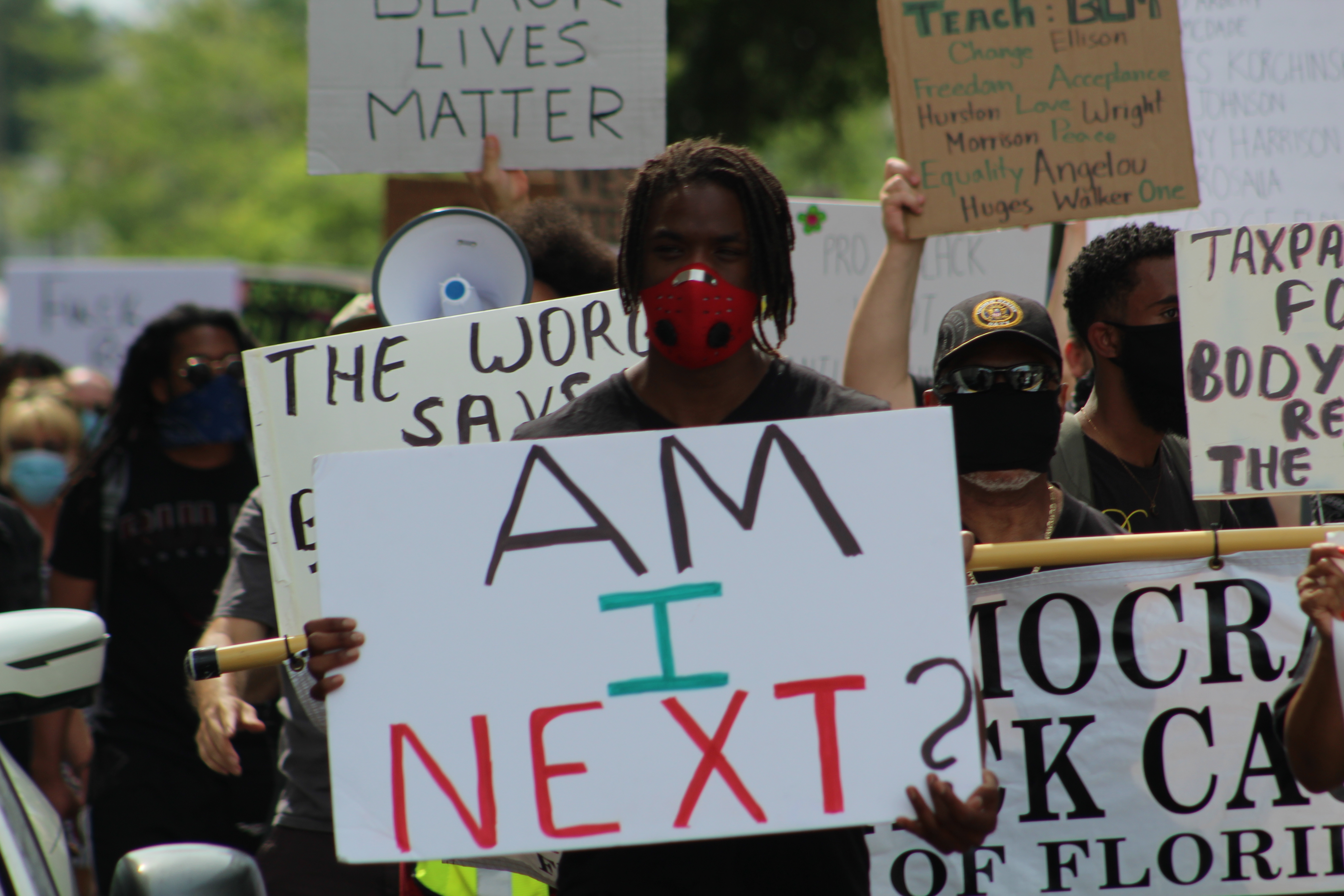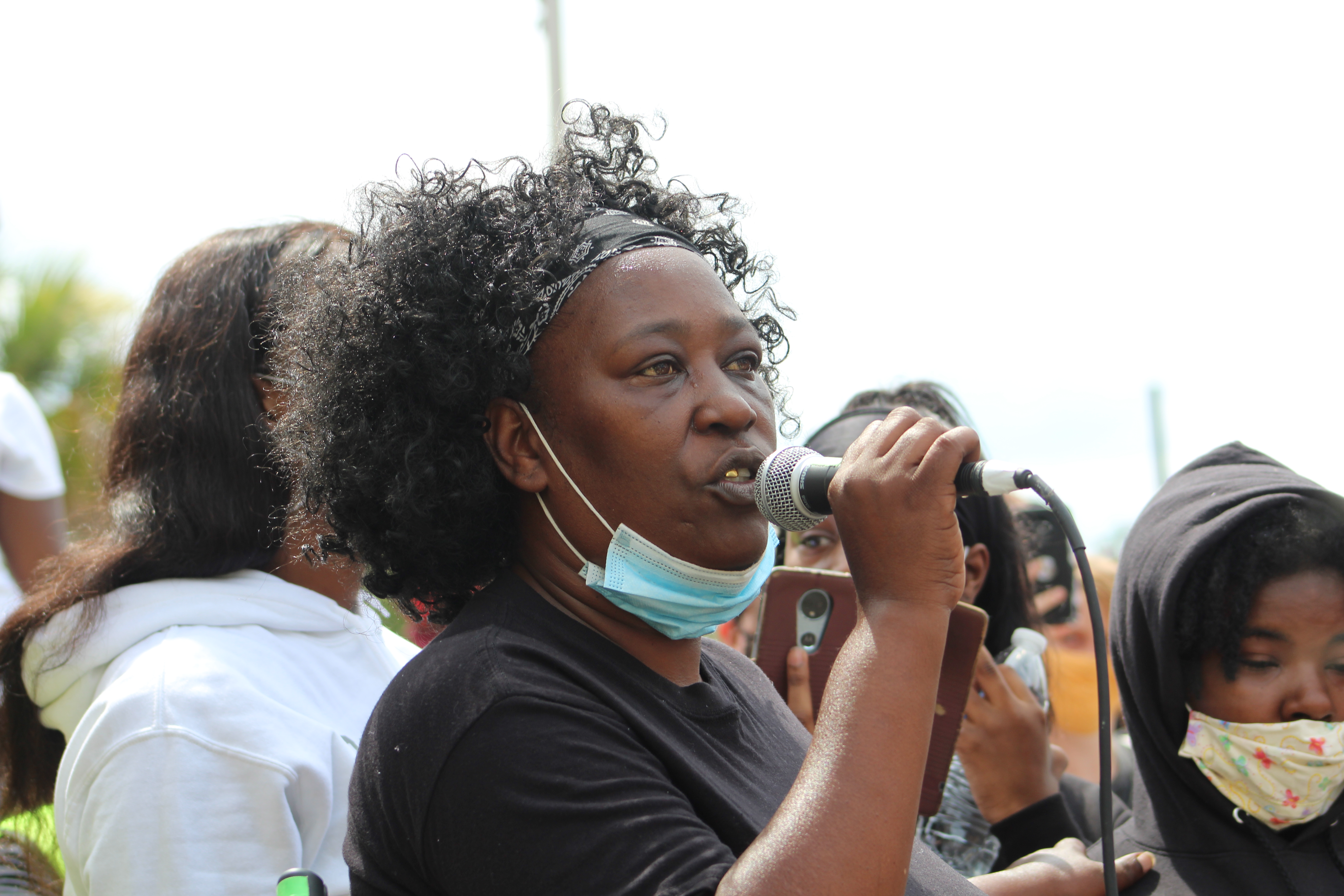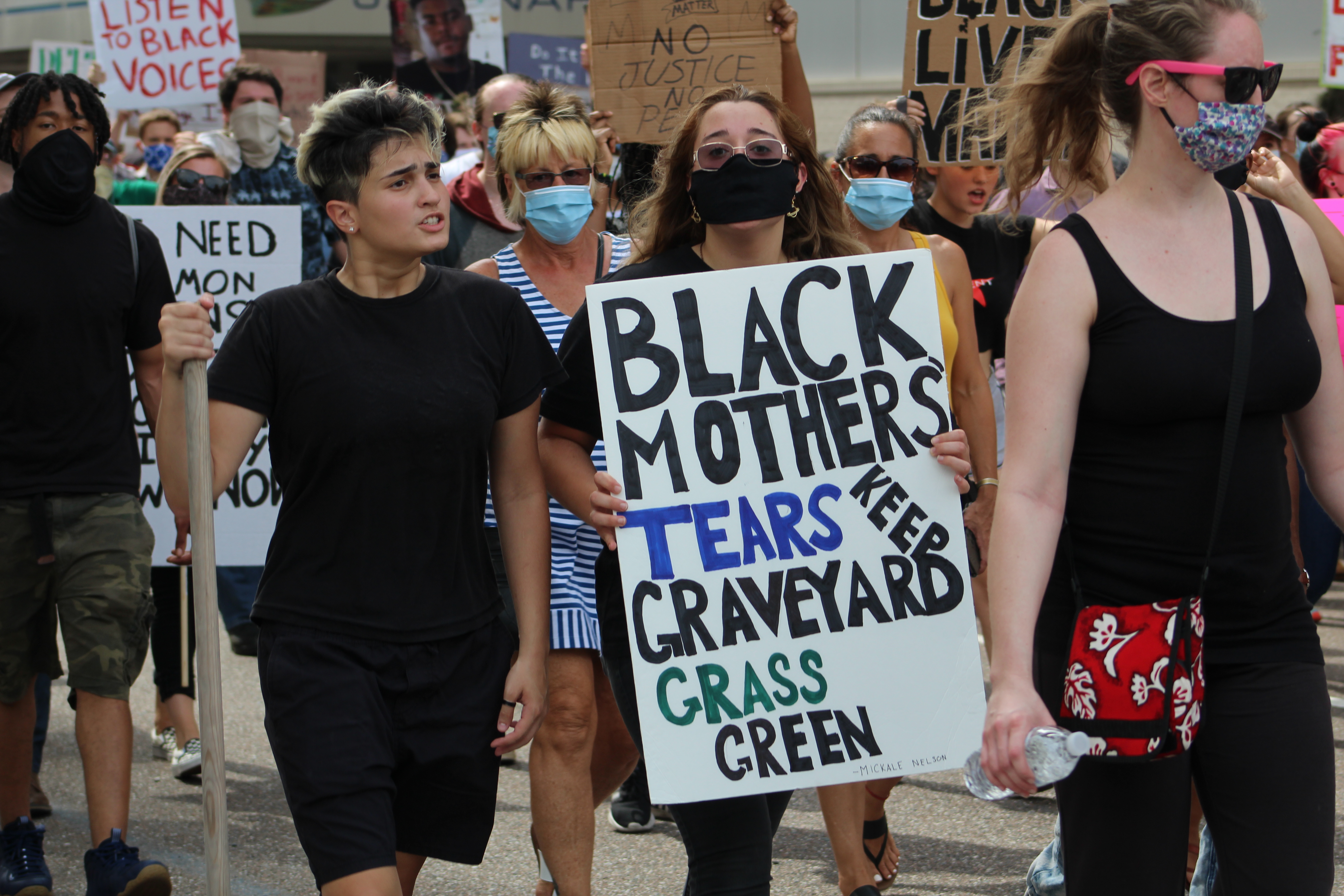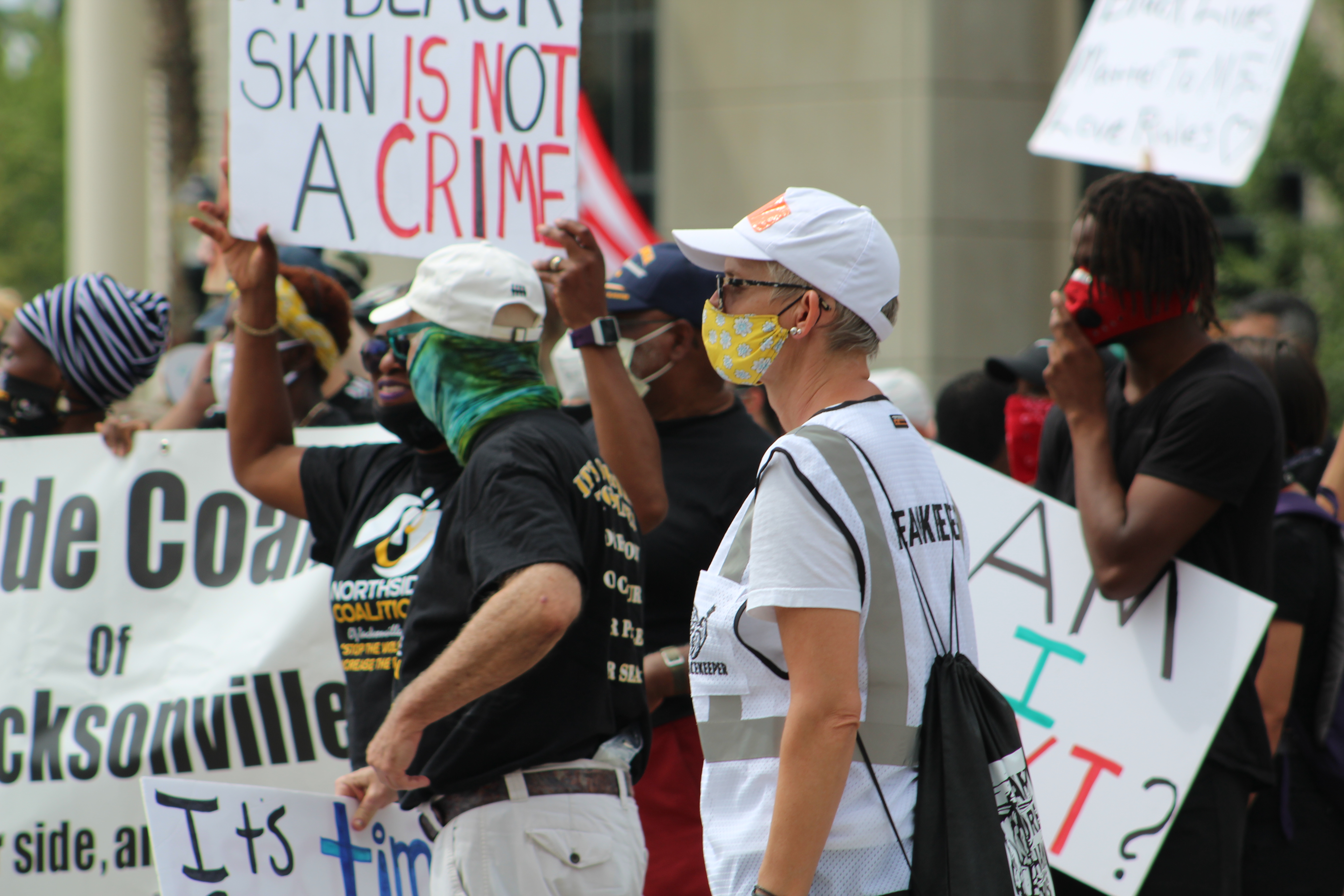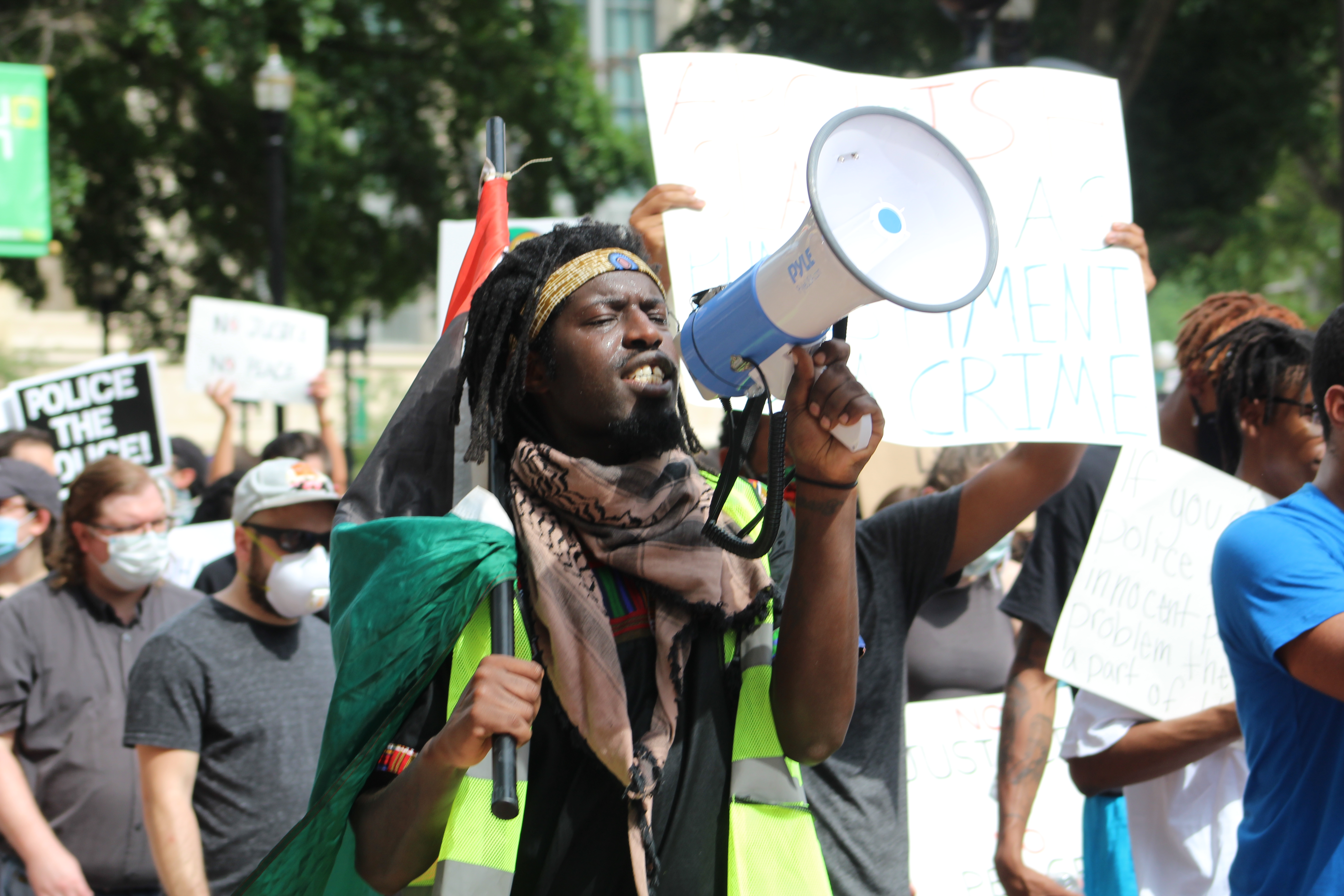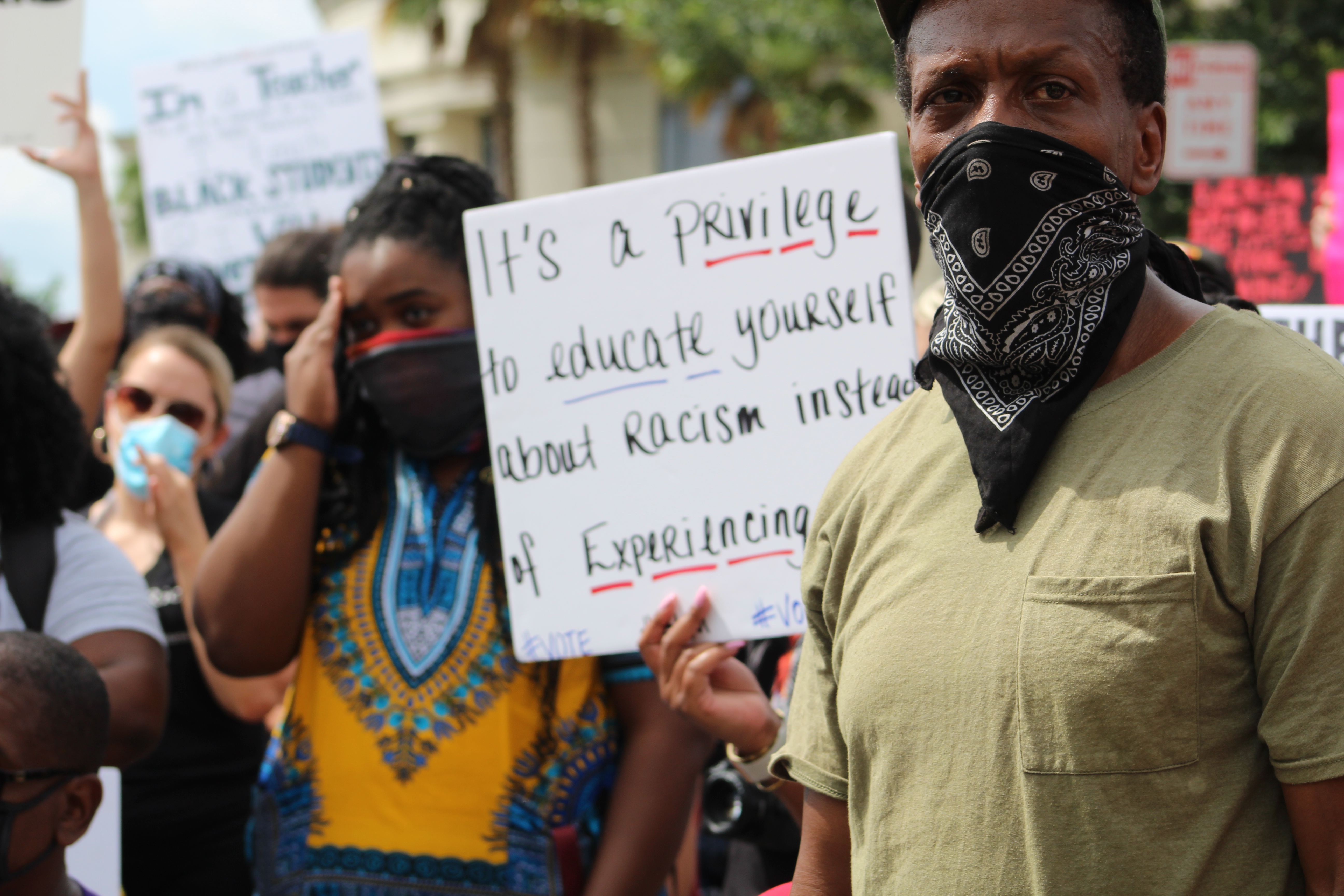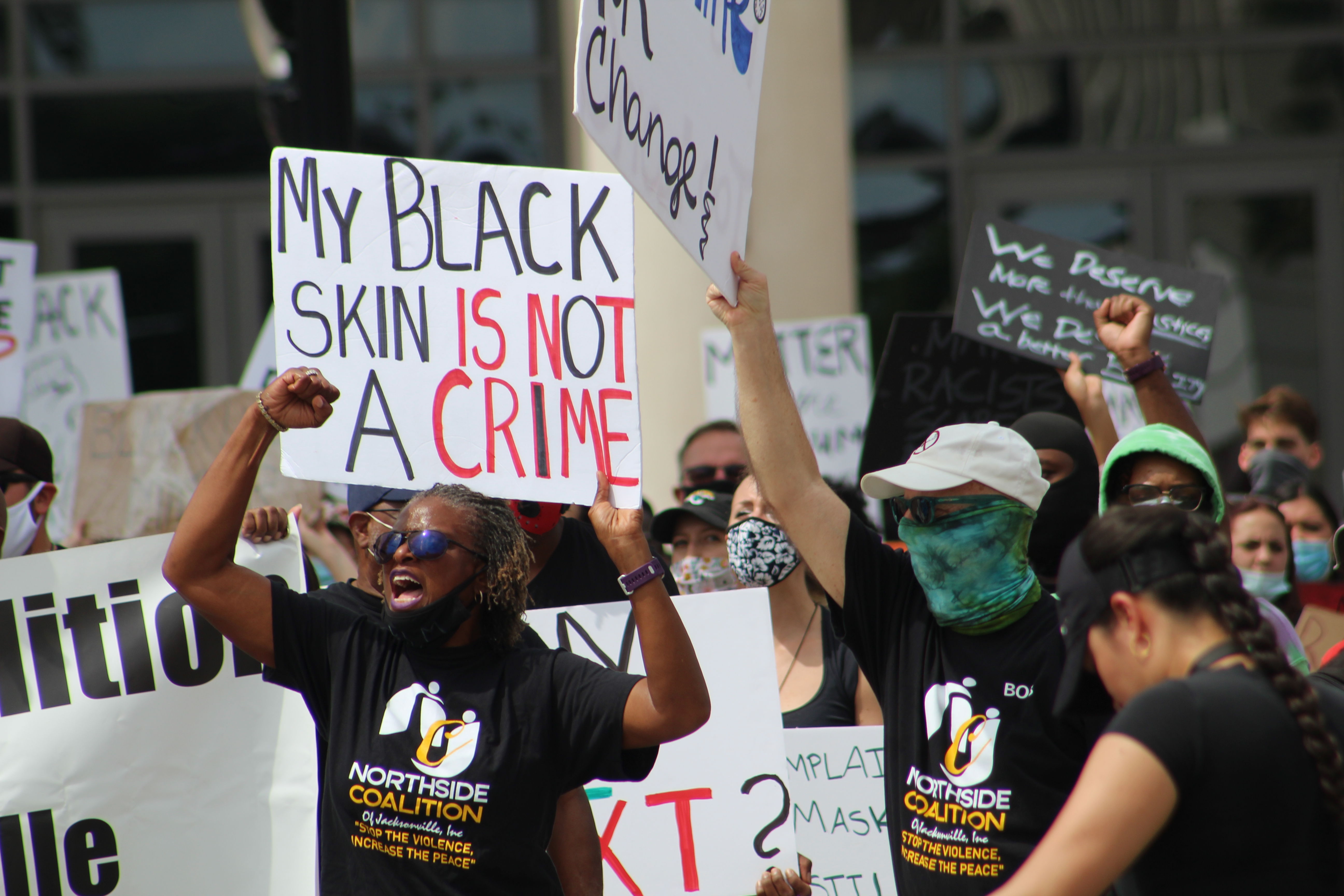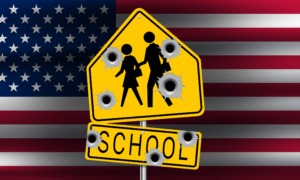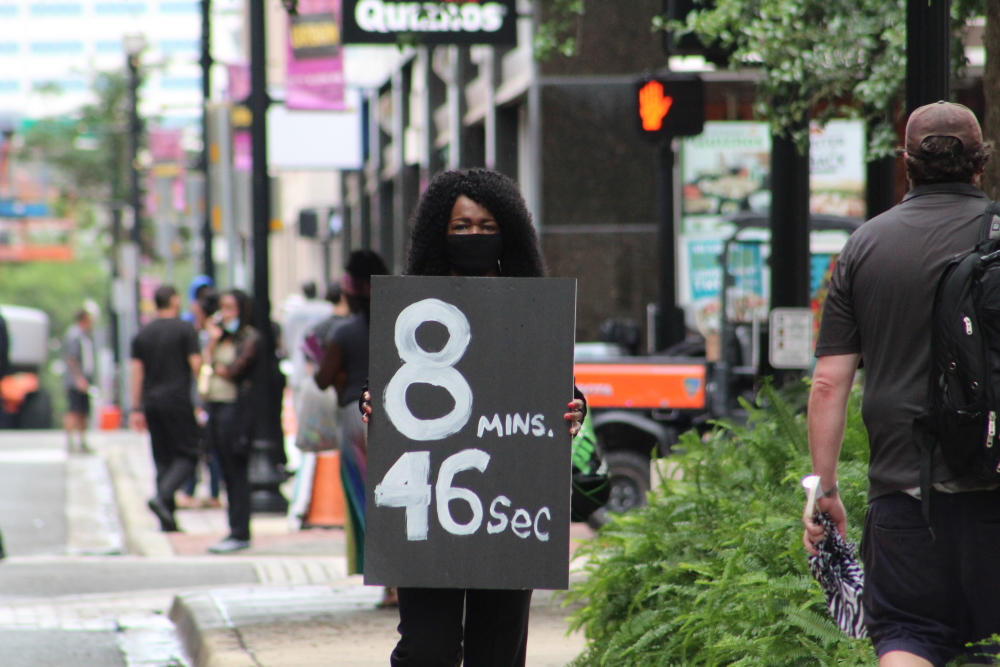
Photos and slideshow by Claire Goforth
At a June 6 rally in Jacksonville, Florida, a woman holds a sign with the exact amount of time Minneapolis police knelt on George Floyd’s neck, killing him.
►►►Scroll down for slideshow
JACKSONVILLE, Fla. — It was drizzling steadily on June 6 when one of the largest civil rights protests in Jacksonville history began amassing in front of the courthouse. The rain stopped by the time protesters took to the streets, flanked by peacekeepers and organizers with bullhorns leading chants of “Hey hey, ho ho, racist cops have got to go,” “No justice, no peace” and the like.
Organizers say up to an estimated 10,000 people marched for racial equality and police reform that day. The crowd skewed young, but all ages were represented; demographics ran the gamut. The signs they carried bore photos of those killed by police and messages like “Shoot all cops with camera phones,” “Hold cops accountable” and the ubiquitous “Black lives matter.”
Michael Sampson II was among them. A leader with the Jacksonville Community Action Committee (JCAC), which hosted the event, the 31-year-old union organizer’s mood was somber and focused as he chanted and marched in a black T-shirt that read, “Community control of police now.”
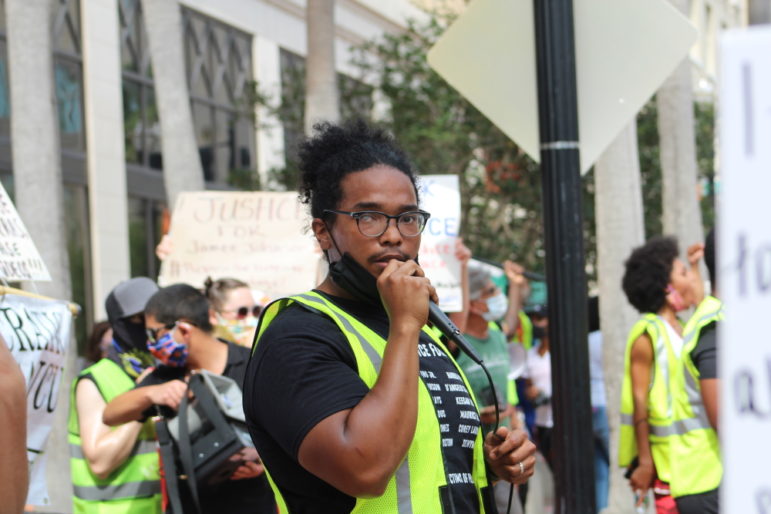
Michael Sampson II, an organizer with the Jacksonville Community Action Committee, speaks at a June 6 rally and march from the Duval County Courthouse.
The march was the eighth straight day of action after the May 25 death of George Floyd, a Black man killed by a white Minneapolis police officer, sparked outrage nationwide. Still more events calling for racial justice and criminal justice reform are planned for coming weeks.
The thousands who have taken to Jacksonville’s streets to demand criminal justice reform say police are too violent, particularly toward Black people. They want body camera footage of shootings quickly released, officers more frequently held accountable, greater transparency in the process and other reforms.
Their efforts are beginning to bear fruit — though all agree there is much work to be done.
Local protests are led by a large coalition of groups that, in spite of differing priorities and, at times, approaches, have come together to focus on effecting change.
“We’ve been very principled in maintaining that united front,” Sampson said.
The protests in Jacksonville have been largely peaceful. Only one, on May 30, turned violent. Police and rescue vehicles were damaged, windows smashed and one officer was injured. Dozens of protesters were arrested. Jacksonville Sheriff Mike Williams has called it a “riot.” Arrests continued the following day at a protest outside the courthouse that attendees described as peaceful.
The Jacksonville Sheriff’s Office (JSO) said 79 were arrested over those two days. Some videos seem to back up claims that many arrested were protesting peacefully. One video from May 30 showed an officer running across the street to violently punch a demonstrator in the face while another officer held him in a chokehold. That day WJCT News captured footage of police using what looked to be flash grenades and pepper spray. Another video from May 31 showed the arrest of a former minister who was urging people to obey police.
Organizers decried the arrests and launched a GoFundMe to pay bail, medical expenses and costs of future events. To date, it’s raised more than $100,000.
Charges against 48 were later dropped. Following the arrests, the protests grew.
“The sheriff’s drastic action mobilized a lot of people in the community to support us in a way that we had never seen before,” Sampson said.
When police respond to mental health crises
The morning of July 7, 2018, was challenging, though typical, for Jacqueline Weaver and her 52-year-old son, Harold “Bert” Kraai. Permanently brain damaged in childhood in the car accident that killed his father, Kraai was schizophrenic and severely mentally handicapped. Disruptions in his routine could cause significant distress, his mother said.
She usually made him breakfast, but he said he wasn’t hungry, so she left to run an errand. But Kraai soon came outside, yelling for breakfast. She told her son she’d be back soon.
“He turned around and he took his fist and put it through the back of my window … [cutting his arm] wide open,” said Weaver. She was not in the car at the time.
He fled, bleeding profusely, and locked himself in the house. Weaver called 911. It wasn’t the first time. JSO had been to the house eight times in the previous two years for reasons including domestic violence, mental illness, armed domestic dispute and suicide threats; four additional times were to involuntarily commit him, The Florida Times-Union reported. Kraai was large — well over 6 feet tall and around 300 pounds — and Weaver said she sometimes asked officers to help her take him to doctor’s appointments or, in more serious cases, to commit him. He’d been in a state hospital for seven months until that January, when insurance stopped paying.
When officers didn’t immediately show, Weaver, worried he would bleed to death, decided to get her other son, who lived three miles away, to help her get inside.
“When we come back, Harold was laying dead in the yard,” Weaver said.
Unbeknownst to her, he’d also called 911, saying he wanted to die and had weapons, according to a JSO spokesperson. JSO said that Kraai was on the porch when an officer arrived. He advanced, police say, brandishing a knife and yelling for the officer to kill him. When he ignored multiple commands to drop the knife, the officer fired eight shots from several feet away, killing him. Roughly 10 seconds passed from the officer’s arrival to his opening fire.
Weaver insists her son wouldn’t hurt anyone and that his was a mental health issue, not a legitimate threat of violence. She says JSO’s own records of calls to the house prove that.
Activists point to deaths like Kraai’s as evidence that mental health professionals, not police, should attend to such matters, one of many reforms they’re seeking.
“They are not equipped to handle mentally ill people,” Weaver said. “They get mad with them. They don’t have the patience.”
Becoming a licensed therapist in Florida requires a master’s degree and nearly 3,000 hours of supervised practice. At a press conference about Kraai’s death, JSO’s chief of investigations said that officers receive 48 hours of training on handling mentally ill people — 40 during police academy and eight in a program added in recent years called “mental health first aid.”
“[Harold Kraai] would still be alive if instead of sending an officer with a gun, you send a mental health expert,” said Sampson, the activist.
Cleared of wrongdoing
Many protesting of late complain that JSO officers are rarely punished. Nearly a year after Kraai’s death, the State Attorney’s Office (SAO) for the 4th Judicial Circuit cleared the officer of wrongdoing, holding he had a reasonable fear for his life. JSO also determined he hadn’t violated its use of force policy.
Last year, only two of 43 use-of-force complaints were sustained. That year there were nearly 900 use-of-force incidents, which include nine shootings, six of them fatal.
State Attorney Melissa Nelson’s office said that since she took office in 2017, it has prosecuted roughly 30 police officers in Duval, Clay and Nassau counties for on- and off-duty conduct. Last year, JSO had 1,700 officers. That year 1,180 complaints were filed against police; just 222 were sustained, according to JSO. And officers’ complaints were far more likely to be sustained. Of the 222, 156 were made by officers.
As punishment, nearly 80% received a written reprimand or counseling; 13% resigned, retired or were fired; and 8% were suspended or demoted.
The vast majority of complaints against JSO officers in 2019 were made by citizens as compared to officers (972 and 208, respectively).
Advocates have long believed that police are overprotective of their own, and that the law shields them excessively. Basically, violent force is legally justified by an officer’s reasonable belief that it’s necessary to protect themselves or others. The Law Enforcement Officers’ Bill of Rights codified in Florida law provides significant procedural protections in the event of an internal investigation.
At recent protests, people have carried signs demanding police be held accountable; many have criticized the police union for making it overly difficult to weed out bad officers.
Where is the tape?
Another protester complaint is what they say is a lack of transparency and lengthy delays between police-involved shootings and the release of body camera footage and decisions to discipline or prosecute.
Some were surprised when, during a public Zoom meeting with state representatives and community leaders on June 8, Sheriff Williams announced that deciding when to release tape was the SAO’s purview. Most were operating under the assumption that JSO had discretion over releasing footage.
Williams also said during the meeting that legislation is needed to standardize when to release the footage and who does so.
“Certainly [state] Rep. [Tracie] Davis and I will work on the legislative fix,” responded state Sen. Audrey Gibson, who was also on the call. Both are Democrats.
In recent weeks, Williams has committed to providing prosecutors with JSO’s full investigation within 30 days of a police-involved shooting, after which time the clock would start ticking for the SAO to release footage. Nelson has vowed that her office is listening to the public and working to address concerns over delays.
If the SAO creates a fixed deadline to release footage, it would be a significant departure from current practice. The footage released on June 18, the first to be released in Jacksonville ever, is from last summer. The SAO issued its decision deeming the deadly shooting justifiable in March; its full report is dated June 9. While the decisions are brief, single-paragraph letters, reports are lengthy and detailed, analyzing all evidence and applicable law.
According to JSO’s transparency page, since Tony Smith was killed by police on Oct. 31, 2018, the SAO has issued decisions in five of 24 police shootings, 16 of them deadly. On Monday, it released body camera footage and its decision from the police shooting of Jamee Johnson, who was killed on Dec. 14. All five police killings have been deemed justifiable under Florida law.
Organizing for equality
People have been calling for racial equality and police reform in Jacksonville for decades. Inspired by national and local events in recent years, support has swelled and organized.
As a half-million people took to the nation’s capital to protest Donald Trump’s election on Jan. 21, 2017, thousands attended a march organized by the Women’s March Florida Jacksonville Chapter (Jacksonville Women’s March), formed shortly after the election.
The Jacksonville Community Action Committee was born that April, after police beat protesters downtown in Hemming Park, including a Black deaf activist whom multiple cameras captured being punched, shocked with a stun gun and dragged away unconscious. Months later, in August, the deadly Unite the Right rally in Charlottesville, Virginia, organized and attended by white nationalists protesting removing a statue of Robert E. Lee, led to the formation of Take ‘Em Down Jax, which advocated for removing Confederate monuments from public spaces.
Each began strong. “It grew so quickly and was so overwhelming,” said Bonnie Hendrix, president of the Jacksonville Women’s March. Many, like Hendrix, were new to activism.
“I’m not the kind of person that believes that standing on the corner shouting is the best way to get everything done,” said the 62-year-old retiree. “But sometimes it is cathartic and sometimes it does bring attention to issues.”
There are a lot of similarities and overlap, but each group has its own tactics and focus. Jacksonville Women’s March follows the issues of the day, often lending support rather than spearheading the movement. Criminal justice reform-focused JCAC works on behalf of people killed by police, offering help and support as their loved ones seek justice and answers.
Over time, participation has waxed and waned. Sometimes a few hundred attended events; for others only a few dozen showed.
The momentum has shifted in the last month. Footage of the deaths of Floyd, Ahmaud Arbery, a Black man killed by white men in nearby Brunswick, Georgia, and others have galvanized support and inflamed longstanding local tensions with police, much of them based on race.
Recent protest crowds have jumped from the hundreds to the thousands. Perhaps responding to criticisms of officers’ actions on May 30 and 31, police have largely remained out of sight a few blocks away, which helps keep tensions down. Protest organizers, meanwhile, work hard to make sure events are peaceful; they don’t want to distract from their cause.
The attention to detail grows with every event. Masks and water are distributed. Peacekeepers trained in de-escalation tactics and medical staff are on hand, and, recently, attorneys and monitors from the American Civil Liberties Union. Voter registration is available. Multiple groups are represented.
“I think there’s more organizations here working together pursuing a common agenda … [and] we’re definitely more mindful of safety,” Sampson said.
The work is paying off in the form of increased participation and public support, much of it from newcomers.
“What is happening now in my opinion is historic,” said Wells Todd, a leader with Take ‘Em Down Jax.
Other issues with law enforcement
Beneath the blazing sun at a June 13 protest at the courthouse, Yvonno Kemp wept for her son, Reginald Leon Boston Jr., 20, who was killed by police on Jan. 21. She said she has yet to receive body camera footage or even the autopsy report.
“We don’t know what happened to Reginald. We don’t know how many times he got shot,” she told the crowd of several hundred.
Perceived racism in policing is one of the most significant drivers of the wave of protests. Boston was Black. All three of the officers involved in his shooting were white, per JSO. Black Americans are far more likely to be arrested, incarcerated and killed by police. In Jacksonville, where 31% of the population is Black, of the 11 shot so far this year, five, or 45%, were Black, JSO reports.
Police-involved shootings had been trending downward for years. The Florida Times-Union reported that 2018 marked the fewest police shootings in a decade, when five were shot. Four died, including Harold Kraai. Last year, there were nine, six deadly.
So far this year there have been 11 police shootings, seven of them deadly.
While shootings represent a tiny fraction of the nearly 840,000 service calls JSO performed last year, each one sends a shock wave through a family and a community. The perception that police can shoot first, ask questions later and almost never face consequences regardless of the appropriateness of their actions is a key issue that activists mention time and again. They also wonder if the city’s money is well-spent on police, particularly given Jacksonville’s reputation as the murder capital of Florida.
JSO received roughly 40% of the city’s budget this year, $475 million, in the city of roughly 910,000. Sheriff Williams has asked for $6 million more for next year.
The protest movement does not support the increase.
“It’s a catch and incarcerate plan. It’s not a plan that gets to the root cause of a problem,” Hendrix said. “Until they have a real community infrastructure and community support, nothing’s going to change.”
Wheels of change start to turn
On the morning of June 9, the protest movement scored its first big win. People awoke to find that after three years of marching, emailing and protesting, the city had abruptly removed in the dead of night the Confederate soldier statue that has gazed down on Hemming Park for more than a century. A raucous crowd of several hundred gathered in the midmorning heat for a sweaty march alongside Jacksonville Mayor Lenny Curry, Sheriff Williams and several Jacksonville Jaguars football players.
“I have to tell you, I’m happy as hell,” Todd said from behind his mask, gazing at the empty pedestal where the statue once stood. Many were glad to see it go and aren’t backing down from other demands. As the mayor started to announce that all the Confederate monuments on public property were coming down, chants of “We ain’t through” all but drowned him out.
Even Todd, who’d worked harder on removing the statues than most, said the symbolism of taking it down was meaningless without real change.
Tensions were high during the march, partially owing to large numbers of uniformed officers also marching that made a strange juxtaposition with signs opposing police, some bearing the faces of people they’d killed. The names of the dead were shouted at times, along with slogans demanding reform.
Later that day, Take ‘Em Down Jax, JCAC, Jacksonville Women’s March and other groups gathered for a strategy session. They debated priorities — rapid release of body camera footage of police shootings, creating a police accountability board, economic development in neglected Black neighborhoods, releasing nonviolent inmates in the Duval County Pre-Trial Detention Facility during the pandemic, no more military-grade equipment for police — and began drafting a letter with their demands.
“This city could erupt. So could other cities,” Sampson said. “We’re putting forth solutions and being proactive to come up with steps that the state attorney and the sheriff can put forth so that it doesn’t become explosive.”
At the meeting, they also agreed to stop calling to defund police, a controversial demand, and instead focus on shifting JSO’s funding and duties, such as mental health crises and drug overdoses, to other entities they feel better equipped to handle them.
They’re starting to see progress. JSO released its first body camera footage of officer-involved shootings. The City Council has launched a committee to explore issues associated with racial equality. Local government is more engaged than ever.
The activists may not agree on every issue, but they do agree they’re stronger together.
“I enjoy seeing people realize how much power they have in their voice,” Sampson said.
This is the third in a Northeast Florida-focused series collaboration between WJCT and the Center for Sustainable Journalism, which publishes Youth Today and the Juvenile Justice Information Exchange. This series is part of the Center’s national project on gun violence. Support is provided by The Kendeda Fund. The Center is solely responsible for the content and maintains editorial independence.


